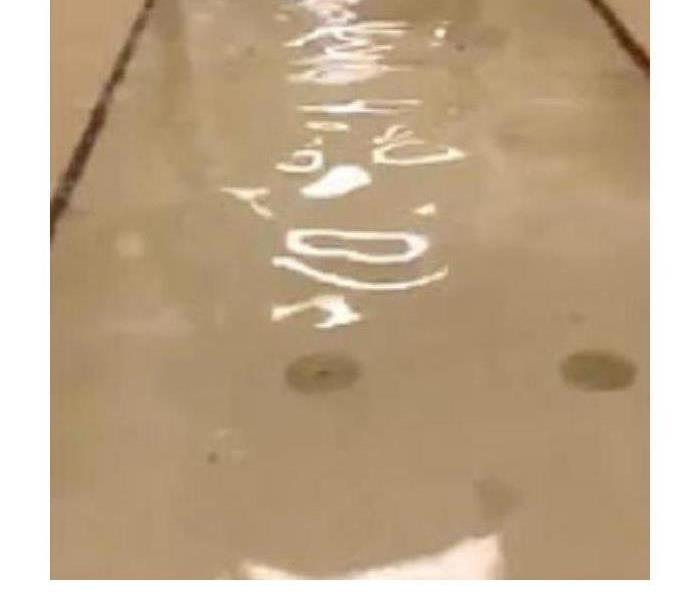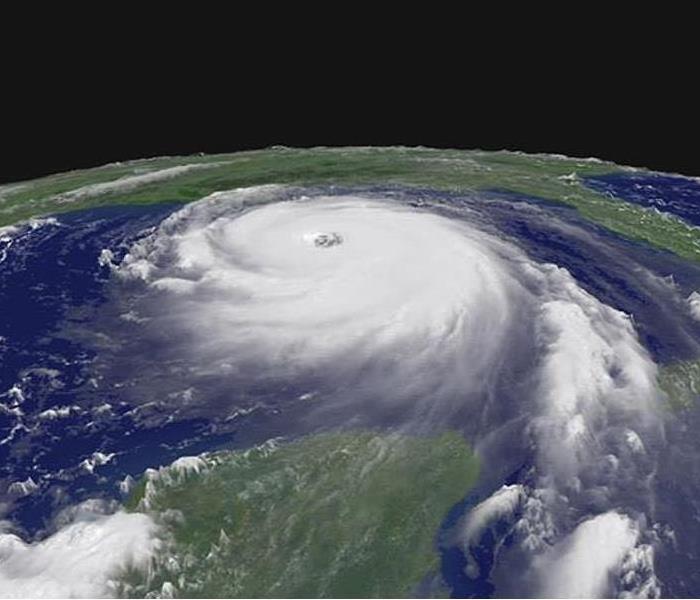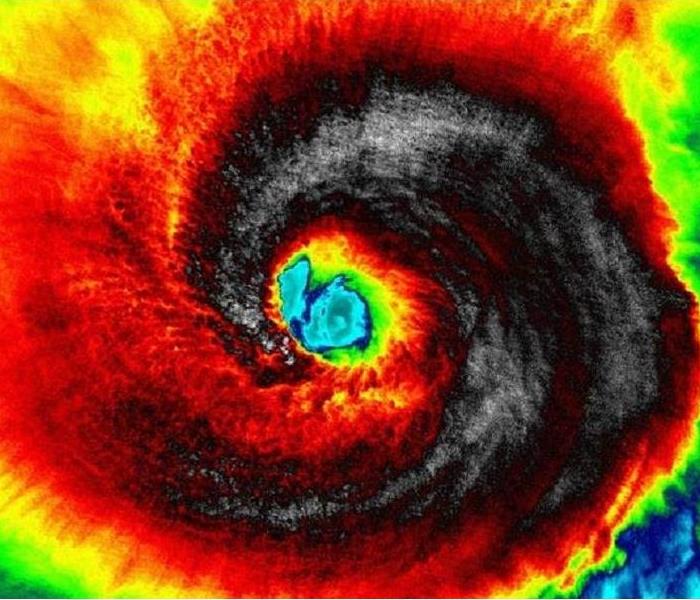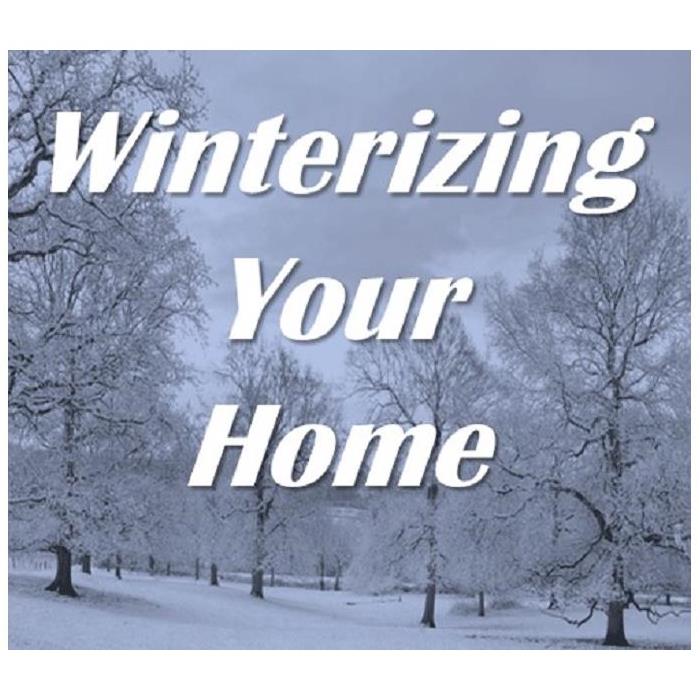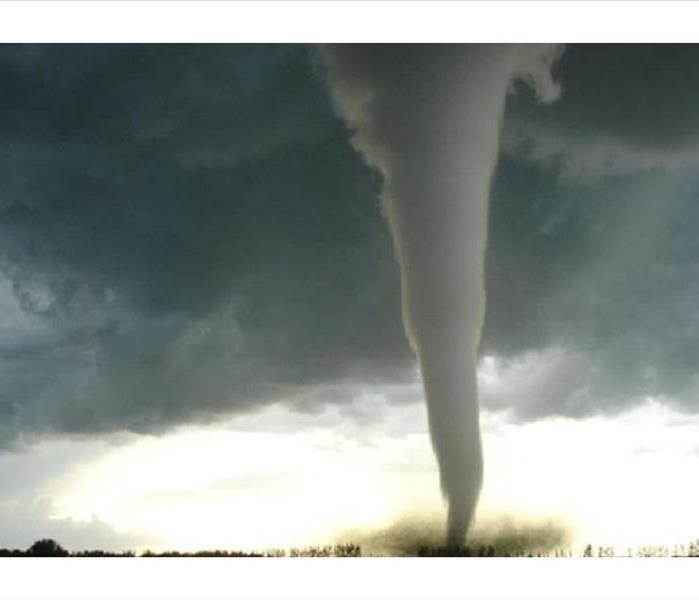Recent Storm Damage Posts
Storm Damage Cleanup and Restoration in Santa Rosa County
9/30/2024 (Permalink)
Storms are a natural part of life, but their aftermath can be chaotic and overwhelming. In Santa Rosa County, dealing with the consequences of storm damage is a recurring reality for many residents and businesses. Effective storm damage cleanup and restoration can be the key to bouncing back quickly and efficiently. At SERVPRO®, we understand the urgency and complexity involved in storm damage restoration and put our expertise into action to provide comprehensive services.
Understanding Storm Damage in Santa Rosa County
Types of Storm Damage
Santa Rosa County is susceptible to a variety of storms, each bringing unique challenges:
- Hurricanes and Tropical Storms: These can cause massive flooding, wind damage, and infrastructure collapse.
- Thunderstorms: Often lead to water damage, downed trees, and power outages.
- Tornadoes: Can result in severe structural damage to homes and businesses.
Common Consequences of Storm Damage
- Water Damage: Flooding and heavy rains can lead to significant water damage inside properties.
- Wind Damage: High-speed winds can rip off roofs, break windows, and knock down trees.
- Structural Issues: Prolonged exposure to the elements can weaken buildings, making them unsafe.
Impact on Daily Life and Business Operations
Storm damage can disrupt daily routines and business operations. For homeowners, it means potential displacement and significant repair costs. Businesses may face prolonged closures, leading to a loss of income and clients. The longer the storm damage remains unaddressed, the more severe the consequences can become.
SERVPRO's Storm Damage Cleanup and Restoration Services
Immediate Response and Assessment
At SERVPRO, we provide an immediate response to storm damage to mitigate further loss:
- 24/7 Emergency Services: Our team is always ready, no matter the time or day, to start the cleanup and restoration process.
- Thorough Damage Assessment: Our experts conduct a comprehensive inspection to identify all areas affected by the storm.
Comprehensive Cleanup Services
Cleaning up after a storm involves several critical steps:
- Water Extraction and Drying: Using advanced equipment, we remove standing water and ensure the area is completely dried to prevent mold growth.
- Debris Removal: From fallen trees to broken glass, our team efficiently clears all debris to make the property safe.
- Sanitization: To ensure a healthy environment, we sanitize all affected areas, eliminating bacteria and contaminants.
Expert Restoration Services
Restoring your property to its pre-storm condition is our priority:
- Structural Repairs: Our team handles everything from minor repairs to major structural reinforcements.
- Roof and Window Repairs: We fix damaged roofs and windows to secure your property against the elements.
- Interior Restoration: This includes drywall repair, painting, and flooring replacement to make your home or business look as good as new.
Why Choose SERVPRO for Storm Damage Cleanup and Restoration?
Experienced and Certified Team
SERVPRO boasts a team of certified professionals trained in the latest cleanup and restoration techniques. Our extensive experience with storm damage in Santa Rosa County ensures that we know exactly how to handle the specific challenges presented by various storm types.
Advanced Technology and Equipment
We utilize state-of-the-art technology and equipment in our cleanup and restoration efforts:
- Moisture Detection Tools: These help us detect hidden moisture to prevent mold and further damage.
- Heavy-duty Extraction Equipment: Ensures efficient water removal, even in the most challenging conditions.
- Industrial-Grade Drying and Dehumidifying Equipment: Speeds up the drying process and mitigates secondary damage.
Commitment to Local Community
Being a locally owned and operated business, SERVPRO is dedicated to helping our community recover from storm damage:
- Community Involvement: We actively participate in community events and initiatives to support Santa Rosa County residents before, during, and after storms.
- Customer-Centric Approach: Our clients’ satisfaction and safety are our highest priorities. We tailor our services to meet your specific needs and ensure a seamless restoration process.
Steps to Take After a Storm: DIY and Professional Assistance
Safety First
After a storm passes, it’s important to ensure your safety:
- Avoid Flood Waters: They can be contaminated and dangerous.
- Inspect for Hazards: Check for downed power lines, gas leaks, and structural damage before entering any building.
Immediate Actions
Taking prompt steps can minimize damage:
- Document the Damage: Take photos and notes to assist with insurance claims.
- Contact SERVPRO: The sooner we can start the cleanup process, the better we can mitigate further loss and expedite restoration.
Professional Restoration
Relying on professionals for storm damage cleanup and restoration ensures thorough and effective results:
- Speedy Recovery: Professionals have the expertise and equipment to restore your property quickly.
- Insurance Assistance: SERVPRO can assist with the insurance claims process, helping you get the compensation you deserve.
Conclusion
Storm damage cleanup and restoration is a complex and urgent task requiring immediate and effective action. In Santa Rosa County, SERVPRO stands as a reliable partner, ready to restore your property and peace of mind. With our experienced team, advanced technology, and commitment to the community, we ensure your home or business returns to normalcy as swiftly as possible. Don’t let storm damage hold you back—reach out to SERVPRO for expert storm damage cleanup and restoration services.
Unpredictable Weather: SERVPRO® Ready to Assist Santa Rosa County All Year Round
12/12/2023 (Permalink)
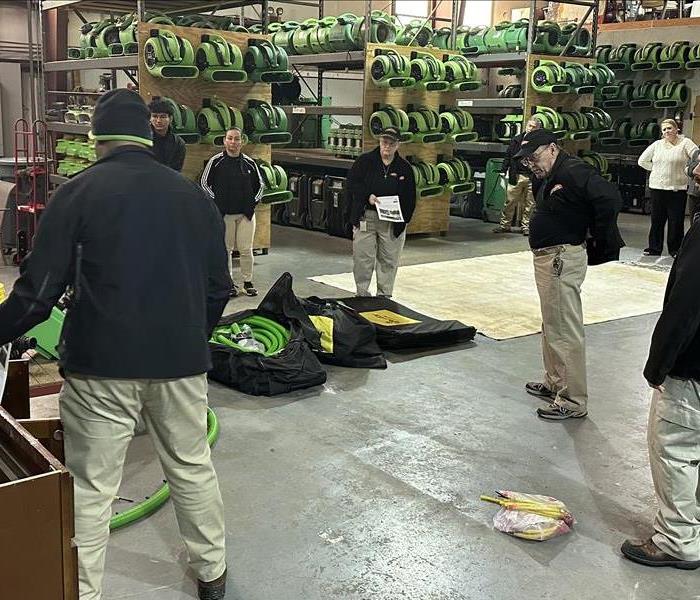 SERVPRO training
SERVPRO training
In Santa Rosa County, the end of hurricane season doesn't necessarily mean the end of stormy weather. Unpredictable weather patterns can still bring heavy rains, strong winds, and other severe weather events at any time of the year. When these storms hit, your trusted neighbors at SERVPRO® are here to lend a helping hand. In this blog post, we want to emphasize that we stand ready to assist Santa Rosa County residents year-round, no matter when disaster strikes.
1. Rapid Response, Anytime:
While hurricane season may have a designated timeframe, storms don't adhere to calendars. SERVPRO® understands the urgency of storm-related damage. Our commitment to a rapid response remains steadfast throughout the year. Whether it's the middle of summer or the depths of winter, our 24/7 emergency response team is always just a phone call away.
2. Versatile Storm Damage Restoration:
Severe weather events can bring a variety of challenges, from flooding and water damage to wind damage and structural issues. SERVPRO® specializes in storm damage restoration services tailored to the specific needs of Santa Rosa County residents. Our experienced professionals are equipped to handle everything from water extraction and structural repairs to debris removal and more.
3. Expertise and Local Knowledge:
As members of the Santa Rosa County community, we have a deep understanding of the unique challenges posed by local weather conditions. We're not just a restoration company; we're your neighbors. Our expertise combined with our knowledge of the area allows us to provide comprehensive storm damage solutions.
4. Insurance Claim Assistance:
Navigating insurance claims can be a daunting task, especially during times of stress and uncertainty. SERVPRO® can assist you with the claims process, working directly with your insurance company to ensure a smooth and efficient experience.
5. A Commitment to the Community:
SERVPRO® is more than just a restoration company; we're an integral part of the Santa Rosa County community. We understand the importance of helping our neighbors during times of need. That's why we're dedicated to providing top-notch storm damage restoration services whenever you require them.
Conclusion:
In Santa Rosa County, storms can strike at any time of the year. Whether it's hurricane season or not, SERVPRO® is here to offer assistance and support when disaster strikes. Our year-round commitment to rapid response, expertise, and community involvement ensures that you have a trusted partner by your side when you need it most. When storms hit, you can count on SERVPRO® to make it "Like it never even happened."
Hurricane Season Facts You Should Know From the SERVPRO Experts That Are Standing By.
9/7/2023 (Permalink)
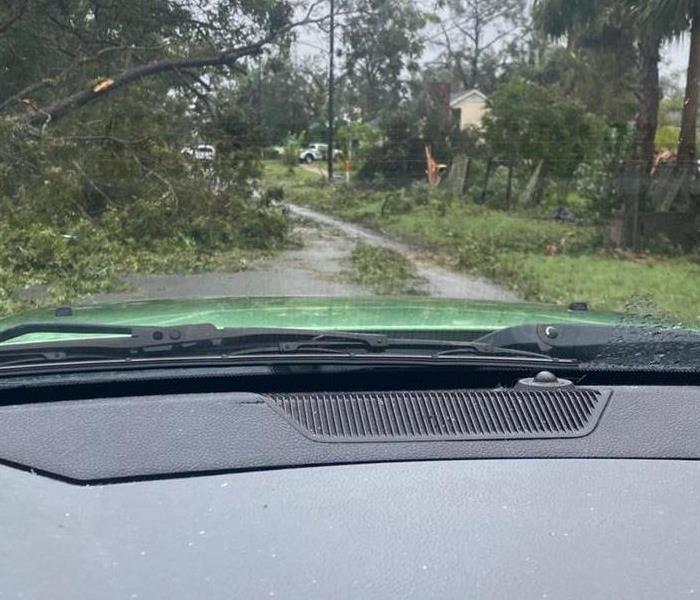 SERVPRO storm team heads out to bring restoration as soon as Hurricane Idalia passed.
SERVPRO storm team heads out to bring restoration as soon as Hurricane Idalia passed.
When most people think about hurricanes, they think about the wind. But it’s the water that usually does the most damage. Torrential rain can cause flash flooding, but a hurricane’s storm surge can be the most destructive and dangerous.
As spring shifts to summer, south Floridians shift their attention to the upcoming hurricane season which begins June 1st and runs through November 30th. The 2021 season was another active year, with a total of twenty-one named storms, including seven hurricanes and four major hurricanes. Eight of these storms hit the United States coastal area, three of which hit Florida. South Florida was spared in 2021 by any major threats, as Tropical Storms Elsa and Fred had little to no impact other than rain.
Hurricanes are rated by categories ranging from one to five. The winds increase with each category. The sustained wind speeds for each category are:
- Category 1 hurricane: 74-95 mph.
- Category 2 hurricane: 96-110 mph.
- Category 3 hurricane: 111-129 mph.
- Category 4 hurricane: 130-156 mph.
- Category 5 hurricane: 156+ mph.
A major hurricane is category 3 strength or higher and can be extremely dangerous to life and property, but it doesn’t take a major hurricane to produce significant impacts. All tropical systems that directly impact south Florida have been known to produce flooding, damaging winds, and tornadoes. It’s important to take every tropical cyclone seriously and keep up to date with tropical outlooks issued daily by the National Hurricane Center.
If your home is ever hit by a storm know here at SERVPRO OF SANTA ROSA COUNTY we are always ready to help you clean up after the storm.
SERVPRO OF SANTA ROSA COUNTY 850-939-4700
ARE YOU PREPARED?
5/25/2022 (Permalink)
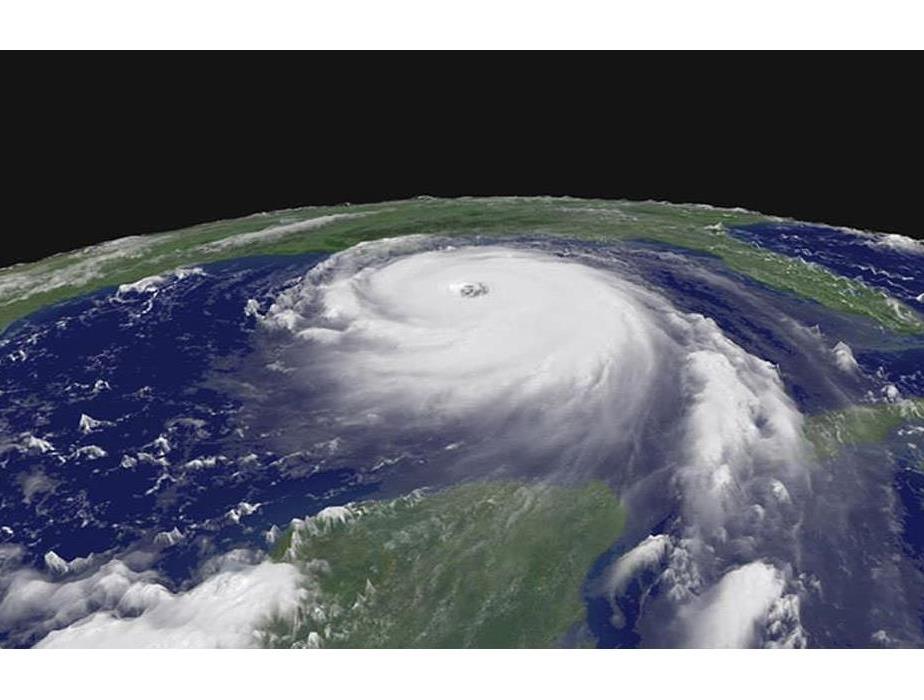 Satellite imagery of Hurricane Katrina in the Gulf of Mexico before it makes landfall in Louisiana.
Satellite imagery of Hurricane Katrina in the Gulf of Mexico before it makes landfall in Louisiana.
With spring storm season here and hurricane season approaching, the question becomes, are you (Emergency Managers), your staff, and your community prepared to respond and recover from whatever mother nature throws your way? Spring storm season 2022 is upon us, with forecasts revealing the jet stream pattern over the North Pacific and the Atlantic to be influenced by the weakening La Nina while a high-pressure system in the Pacific will define the dynamic weather over North America.Hurricane season starts June 1st and continues through November 30th. That is 182 days or roughly one-half of the year that a hurricane could impact your community. Early predictions indicate a 65% chance of an above-average hurricane season for 2022 with 13-18 named storms (winds of 39 MPH or higher), 6-11 of those grow to be hurricanes (winds of 74 MPH or higher), and 2-5 develop to be major hurricanes (winds of 111 MPH or higher).
With this in mind, now is the time for Emergency Managers and communities in tornado-prone areas and areas along the coastline and inland communities to prepare to respond and recover.
Hurricane Names for the 2022 Hurricane Season
Here is a possible top 10 list of preparedness items you should have already discussed and made specific plans for your community.
1- Redundant communication systems. Ensure that your Emergency Responders have more than one means of communication. Depending on the size and severity of the storm, typical means of communication may not be available. It is paramount that you, as an Emergency Manager, can communicate with your field staff, local elected officials, first responders, and any possible mutual aid that may be assisting in the response phase of any operation. Additional options are satellite phones, two-way radio, citizens band radio, amateur radio operators, and social media if internet access is available.
2- Identify major routes for Emergency Medical Services (EMS), Fire, and Police Department use. It is essential for emergency personnel and first responders to get to local medical facilities and other emergency services without delay in a storm. By having pre-identified these routes, you can plan to clean and open the critical roads as quickly as possible and as soon as it is safe for emergency personnel after the storm passes. Ensure that your stand-by contract has a cut-and-push plan established and that you have communicated with your debris removal contractor before landfall.
3- Estimate your community's worst-case scenario for a minor and major hurricane. How much debris could impact your community in each situation? By being prepared with estimates, you can communicate these estimates to your debris contractor, who can secure enough equipment and personnel to respond to your community. It is vital to make your debris removal contractor and monitoring firm part of your Debris Management Plan and your planning process.
4- Have a stand-by contract for both your debris removal contractor and your removal monitoring firm. We have mentioned stand-by contracts previously; however, [I can't emphasize enough the importance of this step in your debris management process]. Proper contracting can be a long process. Preparing a Request for Proposal (RFP), publishing the RFP and soliciting bids, scoring incoming submissions, and ensuring that you have complied with federal procurement procedures, laws, and regulations found in 2 CFR §200 can be an overwhelming task, especially for small jurisdictions. It is less stressful to get this step done in peacetime before any post-event efforts.
5- Personnel Identified, trained, and in place to promote a rapid response. This should be part of your Debris Management Plan. Personnel may be inaccessible post-landfall, and communications may be spotty at best. It is imperative to have these folks identified, trained, and in place to respond to any event quickly. Ensure their phone numbers are available for the information sharing and reporting necessary for any response operation.
6- Identify Temporary Debris Storage and Reduction Sites (TDSRS). You can save a significant amount of time by having these sites pre-identified. Additionally, pre-identify the permanent landfill or final disposition sites. This information will be needed by the Federal Emergency Management Agency (FEMA) if the event becomes a declared Emergency or Major Disaster. Note from 2021; different states have different Environmental and Historic considerations for temporary debris sites. Ensure you know the latest guidance for your state's Department of Environmental Quality and State Historic Preservation Officer.
7- Request approval from your State Department of Environmental Quality for your TDSRS. As soon as it is safe for emergency personnel post-event, ensure that you make the call to your State Department of Environmental Quality (DEQ) to get approval for your TDSRS. Typically this is necessary regardless if the event becomes declared or not. The DEQ contact and phone number handy will make this step a breeze in the hectic post-event environment.
8- Identify methods of debris reduction. With landfill capacity becoming an issue throughout the United States and worldwide, we must plan to reduce storm debris by any means possible. Having this step decided will make your debris operations more efficient and shorten the time to completion. Vegetative debris methods include chipping (65%-75% reduction in volume) or burning (90% reduction in volume). Wood chips are valuable as most landfills will accept them for cover at no charge to your community. Construction and Demolition (C&D) debris can be compressed and then transported to its final disposition in a landfill that accepts C&D debris.
9- Plan for the transition from response to recovery. Debris operations typically consist of two phases. The response phase includes the initial cut and push to open emergency routes and the recovery phase, where debris moves from the right-of-way to the TDSRS or final disposition. These are two different and distinct steps, and you must plan accordingly. The response phase is much shorter, while the recovery phase could take up to a year, depending on the event's severity. Having this plan in place will lessen the stress while in emergencies.
10- Estimate your completion date. What does your completion look like for your community? How many passes will you allow? What will be the last date you will allow storm debris to come to the curb? How will you communicate this to your citizens? By understanding these questions, you can move forward to completion much quicker than planning under emergency conditions.
With these ten tips, you will be better prepared to handle any event that might come your way this year and years to come. If your jurisdiction had a well-prepared Debris Management Plan, your work would be 99% complete. A comprehensive Debris Management Plan will be a valuable part of your Emergency Management toolbox with yearly updates. And to round out your planning, stand-by contracts will relieve the stress that is always part of any disaster response.
Tony M. Furr, retired FEMA Emergency Management Specialist and Region 6 Debris Subject Matter Expert (SME), wrote this article. Mr. Furr has taken a position with DRC Emergency Services and serves as Director of Technology Assistance and Training at 110 Veterans Memorial Blvd. Suite 401, Metairie, LA 70005.
HERE WE GO
5/17/2022 (Permalink)
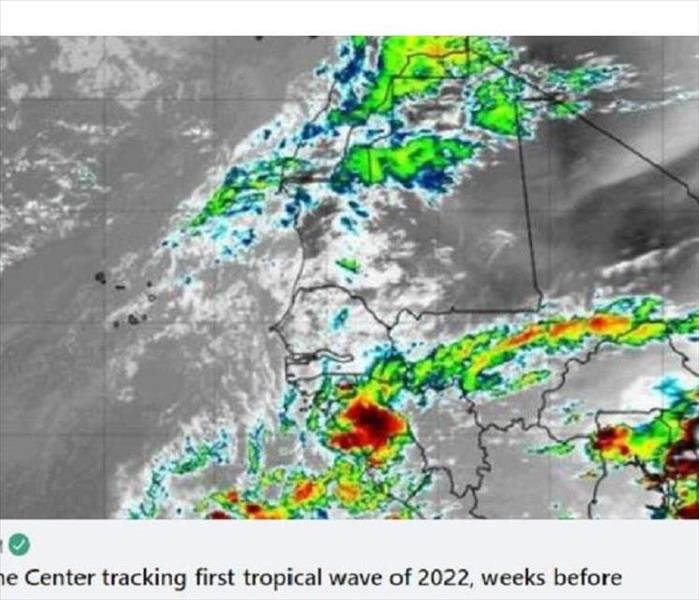 Storm
Storm
Weeks before the Atlantic hurricane season officially starts, the National Hurricane Center in Miami is tracking its first tropical wave of 2022 off the coast of Africa — are you ready?
An eastern Atlantic tropical wave was moving westward about 15 mph, according to a Monday morning NHC report: "The Hovmoller diagram satellite imagery sequence for the past 5 days reveals that this wave has a good track history. The latest satellite imagery shows an area of numerous moderate to isolated strong convection east of the wave. Tropical wave guidance has it moving westward over the next 24-48 hours, passing well to the south of the Cabo Verde Islands."
Name game: Will the trend of hurricane season unofficially starting in May continue?
As hurricane season approaches, experts say to beware of more rapidly intensifying storms
Bookmark this: Here's a free database to track the storms during hurricane season
Hurricane season runs June 1 to Nov. 30. If a tropical storm forms this month, the first name on the list is Alex.
A storm forming before the season starts isn't uncommon. Since 2015, there has been a named storm in May every year, beginning with Tropical Storm Ana. Because of this trend, there has been increasing discussions among weather experts about moving the official start of hurricane season up to May 15.
Here's a recap of past seasons that started before June 1, in some cases, to the extreme:
- On May 8, 2015, Tropical Storm Ana formed, followed by Tropical Storm Bill on June 16th.
- On Jan. 12, 2016, Subtropical Storm Alex formed and eventually strengthened to become Hurricane Alex. Months passed before Tropical Storm Bonnie formed May 27, again days before the official start of the Atlantic hurricane season. Tropical Storm Colin formed June 5 of that year.
Did you know? 2021 hurricane season used up its name list for only the 3rd time in history
Real-time radar loop: See a satellite loop for Eastern Atlantic tropical storm activity
- On April 19, 2017, Tropical Storm Arlene formed. Storm activity was "quiet" until Tropical Storm Bret formed June 19, followed by Tropical Storm Cindy a day later.
- On May 25, 2018, Tropical Storm Alberto formed the weekend of Memorial Day, which was May 28 that year. That summer, hurricane season didn't see another storm until Hurricane Beryl formed July 4 and Hurricane Chris on July 6.
- On May 20, 2019, Subtropical Storm Andrea formed. Hurricane Barry formed months later on July 11.
- On May 16, 2020, during the height of the COVID pandemic, Tropical Storm Arthur formed. Tropical Storm Bertha also formed before the season started, on May 27, two days after Memorial Day that year. Tropical Storm Cristobal formed June 1.
- Like in 2015, Tropical Storm Ana formed May 22, 2021, followed by Tropical Storm Bill on June 14. It is not uncommon for the National Hurricane Center to reuse storm names. If a storm has devastating impacts, names will be retired from future use. That happened with Katrina, Matthew and Floyd, to name a few.
How Do They Form
3/1/2022 (Permalink)
Everyone that lives in coastal areas of the United States know the destruction and fury a Hurricanes can possess. They begin fueling this fury by sucking up heat from warm tropical waters often beginning as a tropical wave. A tropical wave is an area of low pressure that moves again through moisture-rich warm waters, usually enhancing shower activity and thunderstorms.
As this wave moves across the tropics, warm air rises into the storm, forming areas of low-pressure underneath. These areas of low-pressure underneath cause even more air to rush in. Once inside the air rises and cools, this cooling causes clouds and thunderstorms to form. In these clouds the water condenses to form droplets which in turn releases more heat to power a building storm.
Categories are given to storm based on a storms wind speed. To get the classification as a hurricane, wind speeds must reach 74 mph, up until this point it is still just considered a tropical storm. 74 mph winds are nothing to laugh at winds this speed can very easily damage a roof and it shingles, vinyl siding, and gutters. Large branches from trees at this wind speed could very easily snap and shallowly rooted trees could topple. As we all know even winds of just 74 mph at a Category 1 can cause extensive damage to power lines and poles resulting in power outages that could last several hours or several days.
The terms cyclone and hurricane refer to the same tropical storms. They are named differently, depending on the region they occur in. In the North Atlantic Ocean and the Northeast Pacific Ocean, these storms are called Hurricanes, whereas they are called tropical cyclones in the South Pacific and the Indian Ocean.
Hurricanes generate a phenomenal amount of energy. The winds can churn out about half as much energy as the electrical generating capacity of the entire world. Cloud and rain formation from the same storm might release a staggering four hundred times that amount of energy. The energy produced is measured by the amount of water produced by the hurricane and its subsequent condensation — the measurement is called the latent heat of condensation.
With the current technology available, we have no way of harnessing the type of heat energy that a hurricane produces. One day this will be possible.
Hurricane Statistics
3/1/2022 (Permalink)
The five deadliest hurricanes in US history
- The Great Galveston Storm (1990) – the estimated death toll is from 8,000 to 12,000.
- Hurricane Maria (2017) – the estimated death toll is around 5,000. Initial estimates were only 64 in Puerto Rico; new reports showed incredibly more.
- The Okeechobee Hurricane (1928) – the estimated death toll is around 3,000.
- Hurricane Katrina (2005) – the death toll is 1,833. Tens and thousands of people were displaced.
- The Chenière Caminada Hurricane (1893) – The Great October Storm killed nearly 1,400 people, almost the population of a town.
And, two of the deadliest hurricanes in American History are also the top two when it comes to the costliest.
The costliest hurricanes in US history
- Katrina (2005) with 1,833 deaths – $125 billion ($170 billion when normalized for 2020)
- Harvey (2017) with 89 deaths – $125 billion ($131.5 billion)
- Maria (2017) with 2,981- $90 billion ($94.5 billion)
- Sandy (2012) with 159 deaths – $65 billion ($74.1 billion)
- Irma (2017) with 97 deaths – $50 billion ($52.5 billion)
- Ike (2008) with 112 deaths – $30 billion ($36.9 billion)
- Andrew (1992) with 61 deaths – $27 billion ($50.5 billion)
- Michael (2018) with 49 deaths – $25 billion
- Ivan (2004) with 57 deaths – $20.5 billion ($28.7 billion)
- Wilma (2005) with 35 deaths – $19 billion ($25.8 billlion)
The Five Deadliest Hurricanes in US History
(by estimated deaths)
12,000
The Great Galveston Storm (1990)
5,000
Hurricane Maria (2017)
3,000
The Okeechobee Hurricane (1928)
1,833
Hurricane Katrina (2005)
1,400
The Chenière Caminada Hurricane (1893)
Source: USA Today
Created by CompareCamp.com
Hurricanes
2/10/2022 (Permalink)
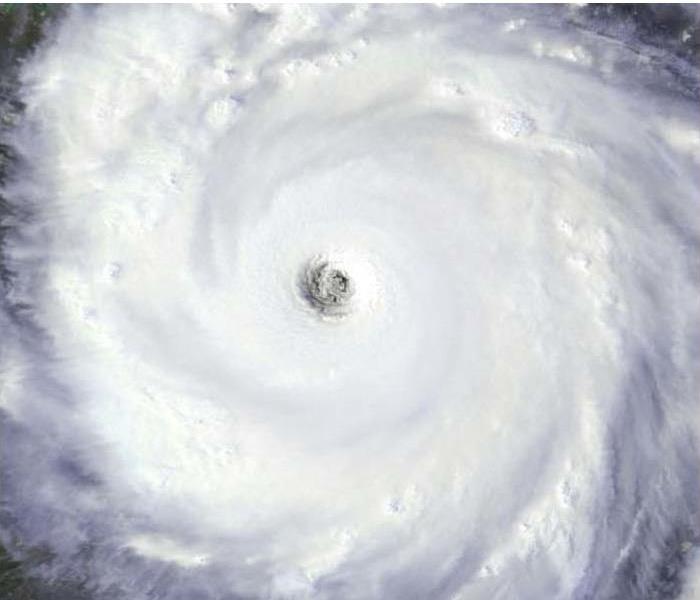 Hurricane Katrina
Hurricane Katrina
Hurricanes
When most people think about hurricanes, they think about the wind. But it’s the water that usually does the most damage. Torrential rain can cause flash flooding, but a hurricane’s storm surge can be the most destructive and dangerous.
As spring shifts to summer, south Floridians shift their attention to the upcoming hurricane season which begins June 1st and runs through November 30th. The 2021 season was another active year, with a total of twenty-one named storms, including seven hurricanes and four major hurricanes. Eight of these storms hit the United States coastal area, three of which hit Florida. South Florida was spared in 2021 by any major threats, as Tropical Storms Elsa and Fred had little to no impact other than rain.
Hurricanes are rated by categories ranging from one to five. The winds increase with each category. The sustained wind speeds for each category are:
- Category 1 hurricane: 74-95 mph.
- Category 2 hurricane: 96-110 mph.
- Category 3 hurricane: 111-129 mph.
- Category 4 hurricane: 130-156 mph.
- Category 5 hurricane: 156+ mph.
A major hurricane is category 3 strength or higher and can be extremely dangerous to life and property, but it doesn’t take a major hurricane to produce significant impacts. All tropical systems that directly impact south Florida have been known to produce flooding, damaging winds, and tornadoes. It’s important to take every tropical cyclone seriously and keep up to date with tropical outlooks issued daily by the National Hurricane Center.
If your home is ever hit by a storm know here at SERVPRO OF SANTA ROSA COUNTY we are always ready to help you clean up after the storm.
SERVPRO OF SANTA ROSA COUNTY 850-939-4700
Winterizing Your Home
2/10/2022 (Permalink)
Winterizing My Home
Daylight saving time always clues me in that colder weather is on its way. Winterizing my home becomes my priority. Florida’s cold front usually bring wind and rain prior to their arrival. Below are some tips to help you complete the winterizing of your home:
- CLEAN THE GUTTERS
Falling leaves can create a buildup in your gutters and cause rainwater to overflow. The water needs a clear path to the downspout. While you are at it, look for areas where gutters are loose and may have torn away from the house. Reattach them using gutter spikes, brackets, or hangers. Clean, well-secured gutters are essential to protect the foundation of your home and reduce the risk of basement flooding.
- CHECK YOUR SMOKE DETECTORS
When you change the clocks to standard time, change the batteries in your smoke detector. Fall is a wonderful time to install new batteries as you are preparing your home for cooler. If your detector chirps that is a sign the battery is low. Always replace the batteries in your detector immediately if they chirp no matter the time of the year. Once you’ve replaced the batteries, always test the smoke detector: It’s as simple as pushing the button to make sure the alarm goes off. Do not forget hardwired smoke detector systems; many have battery backups, and those batteries need to be replaced, too. The life expectancy of a smoke detector is 10 years. These alarms are constantly checking the air for smoke, after 10 years, the effectiveness of the alarm my decrease.
- HIRE A CHIMNEY SWEEP
The National Fire Protection Association recommends an annual chimney inspection. These fireplace pros remove soot and creosote that build up in the chimney and pose a fire risk. A professional chimney sweep, certified through the Chimney Safety Institute of America (CSIA), will clean the chimney and inspect the entire fuel venting system for warped metal on the damper, cracked or collapsed flue tiles, cracks in the exterior masonry and other signs of fire damage. A clean chimney makes it safer to build a fire in the winter; it will also make your fireplace more efficient.
- PERFORM FURNACE MAINTENANCE
Call in the pros before turning on the heat in your home. Regular maintenance ensures that your furnace runs at peak efficiency. Without semiannual maintenance (in the spring before running the air conditioner and in the fall before turning on the heat), airborne allergens may get trapped in the filters, resulting in poor indoor air quality. Always have the furnace inspected to make sure it’s in good working order and changing the filters before starting it up for the first time.
Furnaces that are not cleaned at least once a year can wear out more quickly and can stop working altogether. And soaring energy costs make it more important than ever to ensure the furnace is running efficiently. ?
- WINTERIZE WATER PIPES
Data from the Insurance Information Institute shows that almost 30 percent of homeowners insurance claims were related to water damage and freezing. So, make sure to drain outdoor water faucets and winterize water pipes to reduce the risk.
You can winterize water pipes by locating your hose bib shut-off valve, which may be in a basement or crawl space, and turning it off at the source. For extra protection, purchase a Styrofoam cover that attaches over the outdoor faucets to keep them from freezing.
These quick fixes can provide protection against the elements as temperatures drop. You may also want to shut off water to exterior faucets and drain sprinkler systems for extra protection against freezing pipes and water lines.
- ASSESS WINDOWS AND DOORS
Heat lost through windows and doors can account for up to 30 percent of home energy use, according to the U.S. Department of Energy. To keep heat in the house, look for cracks or gaps in the exterior caulking, check seals around exterior door and add caulking or weather stripping as needed.
SERVPRO OF SANTA ROSA COUNTY
850-939-4700
Signs of Impending Tornadoes
2/10/2022 (Permalink)
Florida is not part of "Tornado Alley," but we for sure get our fair share of severe storms and tornadoes year-round.
Knowing the signs of an impending tornado could save your life:
- Strong, consistent rotation in a cloud base.
- Change in the atmospheric color.
- Intense winds followed by hail.
- Loud continuous roar or rumble that does not fade quickly like thunder.
- Whirling dust or debris on the ground under a cloud base.
Having a plan in place in the event of a tornado’s impact is essential.
If you find yourself in a tornado-warned area, always seek shelter immediately. Try and get yourself to an interior room on the lowest level of the home. Put as many non-windowed walls in-between you and the outside world as possible.
Never shelter in a car during a tornado.
Always have a way to receive weather alerts to stay up to date on tornado watches and warnings.
Storm Surge
2/9/2022 (Permalink)
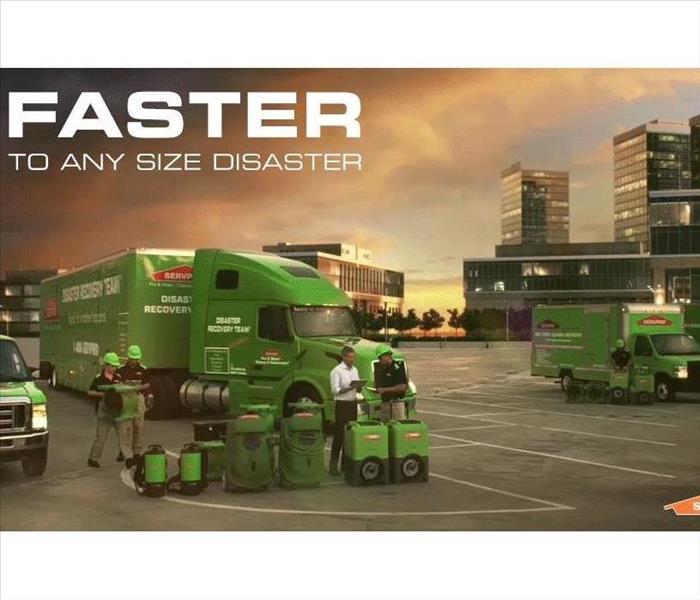 Faster to any size disaster.
Faster to any size disaster.
Storm surge is the unusual rise of water that happens during a big tropical storm. When the water rises, dangerous flooding can happen near the coast. Storm surges are different from high tides, but when a storm surge happens during high tide, it can result in even higher water. Sometimes the water can rise twenty feet and that does not mean there is one 20-foot wave that quickly goes away; it means that the water level rises that much, so it can go extremely far inland if the ground is flat.
The maximum potential storm surge for a particular location depends on a number of different factors. Storm surge is a complex phenomenon because it is sensitive to the slightest changes in storm intensity, forward speed, size (radius of maximum winds-RMW), angle of approach to the coast, central pressure (minimal contribution in comparison to the wind), and the shape and characteristics of coastal features such as bays and estuaries.
The biggest threat to human life during a hurricane is often the storm surge. In previous storms, people have failed to flee because they did not grasp the storm surge's deadly threat. That was the case for 2013's Super Typhoon Haiyan, which left 7,350 dead or missing in the central Philippines, primarily due to the surge. A wall of water estimated to be 24.6ft high, blasted into coastal towns like Tacloban, a city of 240,000 people.
Storm surges can extend for dozens of miles inland, overwhelming buildings quickly and cutting off roads. People can end up drowning in their cars or homes. The walls of water can begin before storms even make landfall, making it harder to sound the alarm in time to save lives.
The best way to avoid storm surge is to remove yourself from harm’s way. Evacuate before the storm hits to keep you and your family safe.
If your home has been damaged by a storm or water intrusion do not delay, call
SERVPRO of Santa Rosa County
850-939-4700
Storm Flooding and Home Air Quality
1/11/2021 (Permalink)
Although water is essential to our lives, it can be devastating when it arrives in large quantities when a storm hits. Many homeowners have experienced this as the victims of flooding. When floodwater flows into the house, it normally brings bugs, debris, and micro-organisms with it. SERVPRO of Santa Rosa County can be your answer.
A lesser-known problem accompanying flooding, however, is the damage it does to the air quality in a home. When items become wet for over 48 hours, they tend to become moldy. Mold spores are not limited to the areas upon which they rest. They float throughout the air and are easily inhaled.
Additionally, floodwater is usually rampant with micro-organisms which may present a health hazard. These organisms are likely to penetrate into porous materials and may later be released into air or other water. High humidity and ongoing moisture provide an ideal environment for these organisms to grow. As time goes on, long-term humidity may also foster the growth of dust mites, which are a major cause of asthma and allergic reactions.
Drying out the flooded house is not a quick process. This is where our trained technicians at SERVPRO of Santa Rosa County come into play. It can take several weeks. Materials such as carpet cannot be adequately dried out and cleaned for future use. These will need to be discarded. Doors and windows should be opened. Cabinet and closet doors should also be opened. Cabinet drawers should be opened as well. Otherwise, they will likely swell and be difficult to open later. Dehumidifiers are very helpful in lowering the level of moisture. If the air conditioner was under water, it should be cleaned before being run. Otherwise, it will likely blow contaminants into the house.
Appliances which are affected by floodwaters should be inspected by a professional before being used again.
Homeowners who live in a flood-prone area should also store hazardous household materials on higher shelves, in an effort to keep them dry in the event of a flood. If these products mix with the floodwater, additional health hazards may result.
If you are dealing with mold that resulted from a flood, we recommend that you call SERVPRO of Santa Rosa County immediately. We have offices in Navarre, Pace/Milton, and Gulf Breeze, Florida. We are here 24/7.
Disaster Response Teams
2/6/2020 (Permalink)
For over 23 years, SERVPRO of Santa Rosa County has assisted property owners with repairs and cleanup to their homes and businesses following catastrophic storms. The damage caused by tornadoes and hurricanes, can range from missing shingles, broken windows, and water damage to complete destruction.
Our Disaster Recover Teams and certified technicians can help you minimize further damages, safely secure your property and begin the cleanup and restoration process. You can count on SERVPRO of Santa Rosa County's Disaster Recovery Response Teams to be in the area following hail storms, tornadoes, large thunderstorms, hurricanes or flash floods to help you with all of your property repair needs. From removing fallen trees to securing windows and doors, no job is too big or too small. We can take on the job from start to finish and make it look "Like it never even happened." We have offices in Navarre, Pace/Milton, and Gulf Breeze, Florida, for quick response time 24/7. HERE TO HELP!
Storm Flooding and Home Air Quality
10/12/2019 (Permalink)
Although water is essential to our lives, it can be devastating when it arrives in large quantities when a storm hits. Many homeowners have experienced this as the victims of flooding. When floodwater flows into the house, it normally brings bugs, debris, and micro-organisms with it. SERVPRO of Santa Rosa County can be your answer.
A lesser-known problem accompanying flooding, however, is the damage it does to the air quality in a home. When items become wet for over 48 hours, they tend to become moldy. Mold spores are not limited to the areas upon which they rest. They float throughout the air and are easily inhaled.
Additionally, floodwater is usually rampant with micro-organisms which may present a health hazard. These organisms are likely to penetrate into porous materials and may later be released into air or other water. High humidity and ongoing moisture provide an ideal environment for these organisms to grow. As time goes on, long-term humidity may also foster the growth of dust mites, which are a major cause of asthma and allergic reactions.
Drying out the flooded house is not a quick process. This is where our trained technicians at SERVPRO of Santa Rosa County come into play. It can take several weeks. Materials such as carpet cannot be adequately dried out and cleaned for future use. These will need to be discarded. Doors and windows should be opened. Cabinet and closet doors should also be opened. Cabinet drawers should be opened as well. Otherwise, they will likely swell and be difficult to open later. Dehumidifiers are very helpful in lowering the level of moisture. If the air conditioner was under water, it should be cleaned before being run. Otherwise, it will likely blow contaminants into the house.
Appliances which are affected by floodwaters should be inspected by a professional before being used again.
Homeowners who live in a flood-prone area should also store hazardous household materials on higher shelves, in an effort to keep them dry in the event of a flood. If these products mix with the floodwater, additional health hazards may result.
If you are dealing with mold that resulted from a flood, we recommend that you call SERVPRO of Santa Rosa County immediately. We have offices in Navarre, Pace/Milton, and Gulf Breeze, Florida. We are here 24/7.
When Storms or Floods hit Pace, Milton, Gulf Breeze, Navarre and surrounding areas, SERVPRO is ready!
10/7/2019 (Permalink)
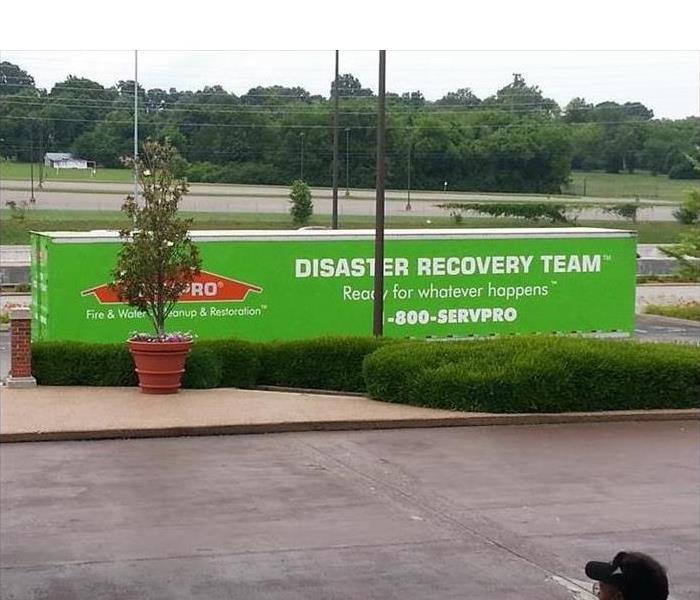 Our highly trained crews are ready to respond 24/7 to storm or flood damage in Pace, Milton, Navarre, Gulf Breeze and surrounding areas.
Our highly trained crews are ready to respond 24/7 to storm or flood damage in Pace, Milton, Navarre, Gulf Breeze and surrounding areas.
SERVPRO of Santa Rosa County specializes in storm and flood damage restoration. Our crews are highly trained and we use specialized equipment to restore your property to its pre-storm condition.
Faster Response
Since we are locally owned and operated, we are able to respond quicker with the right resources, which is extremely important. A fast response lessens the damage, limits further damage, and reduces the restoration cost.
Resources to Handle Floods and Storms
When storms hit SERVPRO Santa Rosa County, we can scale our resources to handle a large storm or flooding disaster. We can access equipment and personnel from a network of 1,650 Franchises across the country and elite Disaster Recovery Teams [[Click to your disaster recovery page]] that are strategically located throughout the United States.
Have Storm or Flood Damage? Call Us Today 850-939-4700
SERVPRO Storm Emergency Restoration
10/7/2019 (Permalink)
At SERVPRO of Santa Rosa County, we know what a difficult time this is for you and your family after a storm destroys your home. That ’s why we’ll do everything possible to get your property back to normal quickly. Our team has the experience to handle all kinds of storm cleanup, and our commitment to your total satisfaction means you can expect impressive results.
Getting your life back in order after a devastating storm takes time. From property repairs to storm debris cleanup, the process can be frustrating, physically taxing, and time-consuming. But we can help. At SERVPRO of Santa Rosa County, we assist property owners with cleanup after damaging storms immediately. We are here to help you in your time of need. We are open 24/7.
SERVPRO of Santa Rosa County-Your LOCAL Storm Restoration Company!
1/24/2018 (Permalink)
As a homeowner, the prospect of having to watch your home and all of the time, money, and memories that you have invested into it get damaged or destroyed by a passing storm is something that can make your blood curdle, but everyday, all of the country, there are homeowners who see this nightmare become a reality, and the recovery process isn't always an easy one. Rebuilding your home and your life in the wake of a particularly devastating storm is a long and arduous process, and it can be both difficult and painful at times, but it doesn't have to be. Here at SERVPRO of Santa Rosa County, we believe that you have been through enough, and we are making it our mission to ensure that you have the help and support you need to get through this difficult time and to completely restore your home. At Disaster Response Group, we are a fully storm restoration service provider for home and business owners all over the country, and as such, we offer a wide variety of high quality restoration services to ensure you get what you need to get you and your family's lives back to normal in the wake of a devastating storm. We are open 24/7 for your convenience! HERE TO HELP!
SERVPRO Storm Emergency Restoration
1/16/2018 (Permalink)
At SERVPRO of Santa Rosa County, we know what a difficult time this is for you and your family after a storm destroys your home. That ’s why we’ll do everything possible to get your property back to normal quickly. Our team has the experience to handle all kinds of storm cleanup, and our commitment to your total satisfaction means you can expect impressive results.
Getting your life back in order after a devastating storm takes time. From property repairs to storm debris cleanup, the process can be frustrating, physically taxing, and time-consuming. But we can help. At SERVPRO of Santa Rosa County, we assist property owners with cleanup after damaging storms immediately. We are here to help you in your time of need. We are open 24/7.

 24/7 Emergency Service
24/7 Emergency Service
